|
|
|
FRESH FRUITS
|
Listed below are some fresh fruits used in Finnish cooking and/or in the recipes of this site.
See also:
|
|
Citrus fruits
(Citrus spp.)
|

|
|

|
|

|
|
Oranges
|
Tangerines
|
Lemon and limes
|

|
|
Depending on the sweetness, tartness or juiciness of the different varieties of citrus fruits, they are either eaten fresh or used in various sweet and savoury dishes and beverages.
Also, the zest and skin are used in various ways.
 In picture on right: blood oranges.
In picture on right: blood oranges.
In Finland, the most commonly consumed citrus varieties are oranges (Citrus sinensis), lemons (Citrus limon), grapefruits (Citrus paradisi),
limes (Citrus aurantifolia), blood oranges (Citrus sinensis), mandarin oranges (Citrus reticulata) and their various hybrids, like tangerines
(Citrus reticulata × Citrus aurantium), clementines (Citrus reticulata × Citrus aurantium) and satsumas (Citrus unshiu).
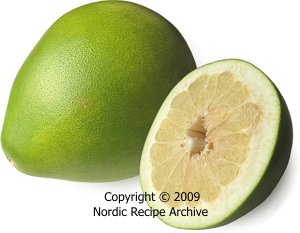 Other varieties include pomelo, pummelo or shaddock (Citrus grandis, C. maxima), kumquat (Fortunella spp.),
tangelo (Citrus paradisi × Citrus reticulata), which is a cross between the mandarin and the grapefruit, sweetie (Citrus paradisi × Citrus grandis), which is a cross between the grapefruit and the pomelo,
and ugli (Citrus paradisi × Citrus reticulata), which is thought to be a cross between the mandarin or the bitter orange and the grapefruit or the pomelo.
Other varieties include pomelo, pummelo or shaddock (Citrus grandis, C. maxima), kumquat (Fortunella spp.),
tangelo (Citrus paradisi × Citrus reticulata), which is a cross between the mandarin and the grapefruit, sweetie (Citrus paradisi × Citrus grandis), which is a cross between the grapefruit and the pomelo,
and ugli (Citrus paradisi × Citrus reticulata), which is thought to be a cross between the mandarin or the bitter orange and the grapefruit or the pomelo.
In picture on right: honey pomelo.
Bitter, sour or Seville orange (Citrus aurantium), citron (Citrus medica), bergamot (Citrus bergamia) and tangor (Citrus nobilis) are less frequently, or hardly ever, encountered in Finnish grocery stores.
Read about fruit juices and zest here.
Read about candied fruit here.
|
|
|

Apple
(Malus × domestica)

One of the most versatile fruits, apples are also one of the few fruits that can be grown in the cold climate of Finland. Apple trees thrive best in southern Finland.
Apples — especially the autumn varieties — can be stored in controlled-atmosphere storage for up to one year.
Finnish apples are never treated with insecticides, waxes, etc, so they can always be eaten without peeling them. Foreign apples imported to Finland should always be peeled before eating, unless they are organically grown.
Besides eaten fresh, apples are used in a multitude of sweet and savoury dishes, like pies, cakes, tarts, sauces, jams, marmalades, purees, chutneys, preserves, meat or vegetable dishes, juices, cider, etc.
Read about dried apples here.
|

|

Pear
(Pyrus communis)

The skin colour of different pear varieties varies from yellowish, reddish and greenish to green and light brown. Their flesh is soft, juicy and fragrant.
Pears are usually harvested before they are fully mature and further ripened in cold storage.
Similarly to apples (see left), pears may be used in a multitude of sweet and savoury dishes, from tarts, pies, cakes, purees, sauces and compotes to chutneys, preserves, meat or vegetable dishes, brandies, liqueurs, etc.
Pears are, in some extent, grown also in southern Finland.
|
|
Banana
(Musa sapienta, M. nana)

Depending on the variety, sweet banana has a firm flesh with a more or less starchy texture, sweetening as the fruit ripens.
Greenish-yellow when raw, unpeeled bananas ripen in a few days in room temperature, eventually turning brown.
Bananas are eaten fresh and added to various sweet and savoury dishes, like salads, ice creams, custards, purees, dips, milkshakes, stews, etc.
Speciality banana varieties, like red or pink bananas or starchy plantains (Musa paradisiaca), may sometimes be found in well-equipped Finnish grocery stores or various ethnic food stores.
|
Kiwi
(Actinidia chinensis)

Kiwi fruit has a greenish-brown hairy skin and an emerald-green flesh with a slightly acidic taste. A newer variety is the golden kiwi (on the right in the picture above), with a smoother skin and a bright yellow flesh. Golden kiwi has a less tart flavour than the green one.
Kiwi is eaten fresh, added to salads, ice creams, sorbets and other desserts or used as a garnish on cakes, tarts, pies and puddings.
It may also be served with various meat, fish or poultry dishes or made into sauces.
After harvest, kiwi will continue to ripen and sweeten in room temperature.
|
|
Grapes
(Vitis spp.)
|

|
|

|
|

|
|
Red grapes
|
Green/white grapes
|
Corinth/champagne grapes
|

|
|
Besides eaten fresh, table grapes may be used in many dishes, like salads, desserts, stews and sauces. They are also dried to make raisins.
Read about raisins here.
Preferably choose sweet and seedless grape varieties to be used in cooking, unless otherwise stated. Grapes do not continue to ripen after harvest.
If the grapes contain seeds, always deseed them before adding to the dish, either by halving the grape and removing the seeds, or if the grapes are to be used whole, using the more laborious way of inserting the bent end of a clean double-pronged hair pin ("bobby pin"/"hair grip") inside the whole grape through the stem end and scooping out the seeds through the hole one by one.
In some dishes, like salads and sauces, grapes are more pleasant to eat if they are peeled, at least if they happen to have unusually tough or thick skins. Peeling is done by cutting a grape in half and removing the skin by scooping out the flesh with the help of a teaspoon, see the illustrated instructions below:
Peeling a grape
 |
 |
 |
 |
 |
| Cut a grape in half and holding one half between your fingers... |
|
... insert the tip of a teaspoon between the grape skin and flesh. |
 |
 |
 |
 |
| |
Slide the teaspoon along the bottom of the grape half,
separating the skin from the flesh |
 |
 |
| |
Repeat with the other half |
|
|
|

Plum
(Prunus domestica)

Of the various plum varieties, the sweetest are eaten fresh. They are added to various desserts, tarts, pies, salads or made into jams, marmalades and preserves. They may also be served to accompany savoury meat dishes.
The colour of plums varies according to the variety, from greenish yellow and yellow to orange, red, bright purple or brownish purple.
Plums continue to mature after harvest.
Plums are one of the few fruits that can be grown in the cold Finnish climate.
Also the small, round and tart damson plums (Prunus domestica var. insititia) have been grown in Finland.
In picture above: sweet Finnish plums grown on the Åland Islands.
Dried plums are called prunes.
Read about prunes here.
|

|

Apricot
(Prunus armeniaca)

Apricot has a light yellow or orange skin and a soft, aromatic flesh.
Apricots usually withstand handling and transporting poorly and should be consumed soon after they have been harvested. They do not continue to ripen after being picked.
Besides eaten fresh, apricots are used to make many desserts, pies, fruit salads, sorbets, pies, jams and preserves.
Confectionary industry uses the apricot kernel to manufacture a cheaper substitute for almond paste. Like bitter almonds, the apricot kernel contains toxic hydrocyanic acid and should therefore be used in small quantities only.
Read about dried apricots here.
|
|
Peach
(Prunus persica)

Peach has a downy, soft skin, the colour of which may vary from a light yellow to a yellow tinged with orange. The flesh is sweet, soft, juicy and fragrant.
Peaches are eaten fresh, added to salads, ice creams, cakes, tarts, pies, sorbets and other desserts and made into jams, compotes, purees, liqueurs, etc.
They may also be served to accompany savoury meat dishes.
Confectionary industry uses the peach kernel to manufacture a cheaper substitute for almond paste. Like bitter almonds, the peach kernel contains toxic hydrocyanic acid and should therefore be used in small quantities only.
Peaches may not ripen properly after they have been picked, so they should be harvested mature and consumed as soon as possible.
Peaches may be replaced with nectarines in most recipes (see right).
|
Nectarine
(Prunus persica var. nectarina)

Nectarine is a smaller variety of peach with a smoother and more colourful skin. Its flesh is firm and juicy, and has a sweet, slightly tart taste.
Besides eaten fresh, nectarines are used in pies, salads, sorbets, preserves, etc, or made into jams, marmalades, purees, liqueurs, etc.
They may also be served to accompany savoury meat dishes.
Nectarines may not ripen properly after they have been picked, so they should be harvested mature.
Nectarines may be replaced with peaches in most recipes (see left).
|
|
Cherry
(Prunus avium)
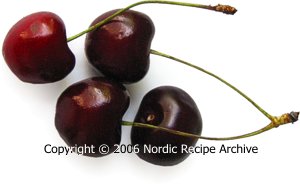
The colour of various cherry varieties varies from almost black or deep red to bright red, orange or yellow. The flesh of sweet cherries is soft and juicy and the flavour aromatic and tasty.
Cherries should be picked ripe since they do not continue to ripen after harvest.
Besides eaten fresh, cherries are used in a multitude of sweet and savoury dishes — from pies, tarts, cakes, soups, compotes, sorbets, ice creams and confections to jams, jellies, preserves, juices, liqueurs and brandies.
The tart sour cherry (Prunus cerasus) is hardly ever eaten fresh, but is cooked, preserved, pickled or made into jams, jellies and liqueurs.
Morello and Montmorency are some of the best known sour cherry varieties.

In picture above: small but sweet and aromatic Finnish cherries grown on the Åland Islands.
|
Persimmon
(Diospyros kaki)
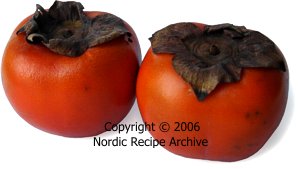
Also called kaki and sharon, persimmon has a thin, bright orange or reddish-orange skin and a soft and gelatinous, sweet flesh. The appearance resembles a tomato.
The skin of a fully ripe persimmon becomes translucent and the flesh is almost liquefied. Persimmon may be ripened in room temperature similarly to avocado (see further below).
Hachiya and Fuyu are two types of Asian persimmons of which the former is inedible when unripe because of its high astringency. The latter, on the other hand, may be eaten before it has fully ripened and thoroughly softened.
Sharon is the name given to Fuyu persimmons produced in Israel.
Persimmon is eaten fresh or added to salads, meat or poultry dishes, etc, or made into sorbets, purees, jams, compotes and marmalades.
|
|
Melons
(Cucumis melo, Citrullus lanatus)
|

|

|
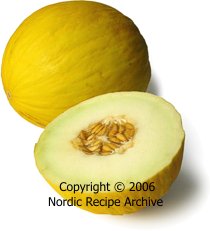
|
|
Galia melon
|
Cantaloupe melons
|
Canary melon
|

|
|
Melons have a hard rind and an extremely juicy, sweet flesh when fully ripe. They are eaten fresh, added to salads, chutneys and pickles or made into soups, purees and sorbets.
Melons are also served with meat, poultry and seafood. The thick rind of certain melons, like the watermelon, may be candied.
Melons are divided into two categories, the early-ripening summer melons and the late-ripening winter melons. The latter usually have a more oblong shape and a longer storage time.
The aroma of most summer melons — except cantaloupes — will continue to improve after harvest, although it will be better if the melons are let to fully ripen on the vine.
Winter melons do not continue to ripen after harvest.
Summer melons:
- Muskmelon (Cucumis melo var. reticulatus) has a net-veined skin, which is sometimes ribbed. Types of muskmelons are also called netted melons or nutmeg melons. Their flesh is usually pinkish, salmon-red or orange.
- Galia melon has a yellow or brownish, netted skin and a flavourful, pale greenish or whitish flesh.
- True cantaloupe melon (Cucumis melo var. cantalupensis) is smaller than muskmelon. It has a pale green or greyish skin, which can be relatively smooth or lightly or deeply ribbed. The flesh is yellowish or orange.
The melons that are called cantaloupes in North America, are usually muskmelons and not true cantaloupes.
Winter melons (Cucumis melo var. inodorus):
- Honeydew melon has a smooth, pale green or yellow skin and a sweet, creamy white, light greenish or orange-greenish flesh.
- Casaba melon has a rough, deeply ribbed, yellow or orange skin and a light, creamy, mild-tasting flesh.
- Canary melon has an oblong shape and a golden yellow skin. Its sweet flesh is whitish, with a hint of pink in the centre.
Other melons with netted skins are the Persian melon, Christmas melon and Santa Claus melon. Other smooth-skinned varieties are the Ogen melon, Prince melon and Crenshaw melon.
 Watermelon (Citrullus lanatus) is usually considerably larger compared to other melons. The skin colour varies from light to dark green and the crisp, juicy flesh is usually red or pinkish, or sometimes whitish or yellowish.
Water melon does not continue to ripen after harvest.
Watermelon (Citrullus lanatus) is usually considerably larger compared to other melons. The skin colour varies from light to dark green and the crisp, juicy flesh is usually red or pinkish, or sometimes whitish or yellowish.
Water melon does not continue to ripen after harvest.
The flesh may be used similar to other melons (see above). Because of the high water content, watermelon is ideal when served in hot weather to quench the thirst.
See a recipe for reindeer and melon appetizer.
|
|
|

Pineapple
(Ananas comosus)

Pineapple has a yellow, more or less sweet and juicy flesh covered with a rough, scale-like skin resembling a pine cone.
Pineapple does not continue to ripen after being picked, but its flesh will get softer. A ripe pineapple feels heavy, yields slightly when pressed and its leaves are green, not browning or yellowing.
Fresh or canned pineapple can be added to salads, cakes, ice cream, sorbets, parfaits and beverages or combined with seafood, chicken, ham and duck.
|

|

Mango
(Mangifera indica)

The size and skin colour of mangoes vary according to the variety. The skin is usually greenish, yellowish or reddish and the flesh yellowish or yellowish-orange.
The flesh of ripe mango is juicy, fragrant and sweet, sometimes with a slight taste reminiscent of turpentine.
Mango continues to ripen after harvest.
Ripe mangoes are eaten fresh, added to desserts, salads, sorbets and beverages, made into jams, compotes and juices or served with savoury ingredients, like chicken or seafood. Unripe mangoes may be served with fish and meat dishes or made into chutneys and other condiments.
|
|
Papaya
(Carica papaya)

Also called papaw, papaya has a yellowish red or yellowish green skin and bright orange flesh, the central cavity of which is filled with black, shiny seeds.
The flesh may be sprinkled with sugar or drizzled with lime or lemon juice. The seeds may be ground and used like pepper.
Papaya goes well paired with avocado (see right).
Unripe, green papaya may be cooked as a vegetable. It is often used to make chutneys and relishes. It contains latex, a white acidic juice that should be drained off before use.
Papaya will continue to ripen after being picked.
|
Avocado
(Persea americana)

Depending on the variety, avocado has a dark brownish-green or bright green skin and a yellowish-green, buttery flesh. The flesh tastes slightly nutty and is very soft when the fruit is ripe.
Avocados ripen in room temperature. To accelerate the process, the fruit may be enclosed in a paper bag together with some ethylene gas releasing fruit, like an apple. Ethylene promotes fruit ripening.
Avocados are eaten fresh and added to various savoury dishes, like salads, sandwiches, seafood dishes, etc. They are made into purees, dressings or soups. They are also used in sweet dishes, like parfaits or mousses. In Finland, avocado is mainly used as a vegetable added to savoury dishes.
See recipes for guacamole and creamy guacamole.
|
|
Passion fruit
(Passiflora edulis)

Also called granadilla, passion fruit has a yellowish-green, orange or brownish purple leathery skin. It contains numerous dark, crisp small seeds enclosed in a juicy and aromatic, gelatinous pulp.
According to the variety, the colour of the pulp may vary from white or pinkish green to greenish-yellow, orange, or yellow.
The slightly acidic flavour of passion fruit is at its best and sweetest when the skin looks wrinkled and "dry". Unripe fruit has a smooth, shiny skin and the pulp tastes tart.
Passion fruit continues to ripen in room temperature, and when it is past its prime, it is very shrivelled and diminished in size, has a hard, withered skin and the pulp has started to dry out.
Both the seeds and the juice and pulp extracted from them may be used in many desserts or to accompany savoury meat or fish dishes.
|
Ground cherry
(Physalis peruviana, P. pubescens)
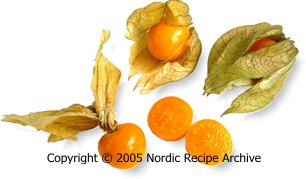
Also known as physalis, Cape gooseberry, alkekengi, Chinese lantern, etc, ground cherry is a small cherry-size berry,
enclosed in a thin, inedible paper-like husk.
The colour of the berry may vary from red and orange to greenish yellow and yellow.
The taste is sweet and slightly acidic, sometimes compared to pineapple, citrus fruits or gooseberry.
Ground cherry continues to ripen after harvest.
Ground cherry may be eaten fresh or cooked. It is used as decoration on cakes or made into jams, marmalades, sorbets, etc.
See recipes for caramel-coated ground cherries and fruit salad.
|
|
Fig
(Ficus carica)

The skin colour of various fig varieties varies from white or green to brown, purple or almost black.
The taste and sweetness vary according to the variety, the purple fig (in picture above) being one of the sweetest and juiciest.
Figs are consumed whole, with skin and the small seeds, either fresh, cooked, poached or baked. They are added to salads, cakes, ice creams and other desserts, made into jams and compotes or served as an accompaniment for many meat and game dishes.
Figs are very perishable and should be eaten as soon as possible after they have been harvested.
Figs do not continue to ripen after harvest.
Read about dried figs here.
|
Pomegranate
(Punica granatum)

Pomegranate has a thick yellowish, green, reddish or orange skin containing numerous fleshy seeds enclosed in sections of bitter, white membrane.
The pinkish seeds have a juicy, tangy-sweet pulp. They are used as an ingredient or decoration in many desserts and sorbets, made into juices, syrups, sauces and condiments, like grenadine and nasharabi (nar-sharab), a sauce served to accompany meat or fish dishes in Georgian or Azerbaijani cuisine.
Pomegranates do not continue to ripen after they have been picked, so they should be harvested mature.
To extract the pomegranate seeds from the fruit, quarter the fruit lengthwise, submerge the pieces in a bowl of cold water and remove the skin and the white membrane, which should rise to the surface, whereas the seeds will sink to the bottom. Drain the seeds on kitchen towels.
Another method is to halve or quarter the fruit, hold the pieces over a large bowl with the cut side down and whack the skin with a wooden spoon, so that the seeds will fling to the bowl beneath. Protect the working area, since pomegranate juice stains easily.
|
|
Rhubarb
(Rheum rhabarbarum)

Although technically a vegetable and a member of the buckwheat family, rhubarb is mainly used like a fruit in cooked or baked sweet dishes, like pies, pastries, soups, jams and juices.
It is also made into chutney-type compotes to be served with savoury meat and fish dishes.
The rhubarb plant contains toxic oxalic acid. While rhubarb stalks are safe to consume in moderate amounts, the leaves have such high amount of oxalic acid (and other harmful substances) that they are considered toxic and must never be used in cooking.
The best season for rhubarb is the spring, when its reddish-green stalks are young and tender. Fresh stalks should be firm and crisp.
See recipes for rhubarb compote and rhubarb pie.
|
Date
(Phoenix dactylifera)
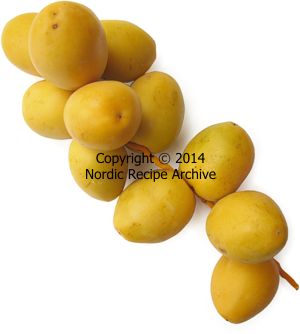
Sweet and juicy dates may be eaten fresh or used in numerous sweet or savoury dishes from stews and sauces to confectionery. Because of their high sugar content, dates are also used to prepare sugar and molasses.
In some Arab countries, dates make a delicious accompaniment for the traditional pale Arab coffee flavoured with cardamom.
Dates do not continue to ripen after they have been picked.
In Finland, fresh dates may sometimes be found sold in ethnic food stores or at deli counters of market halls.
Read about dried dates here.
|
|
|

